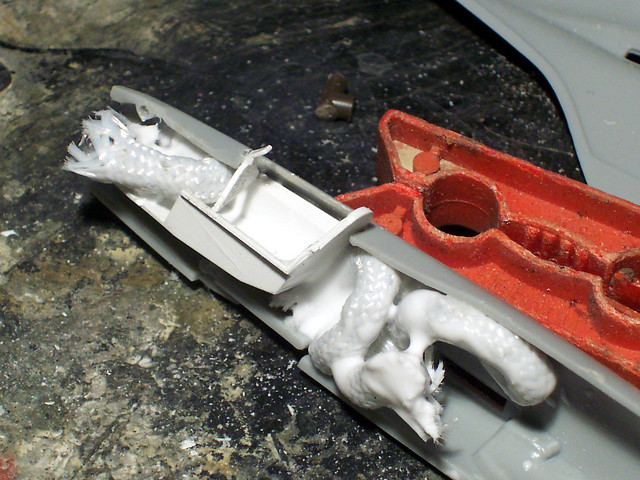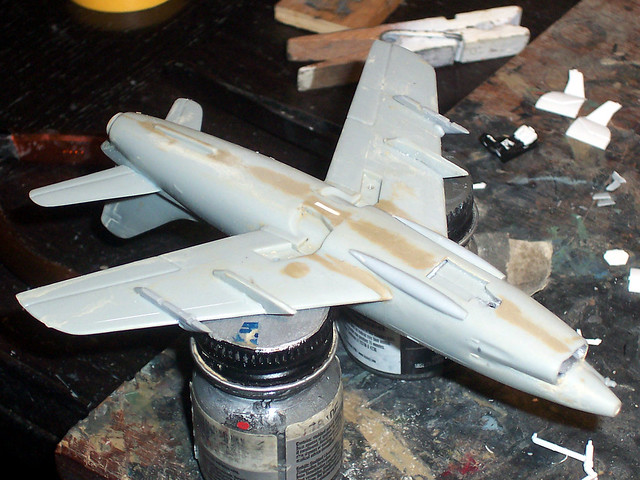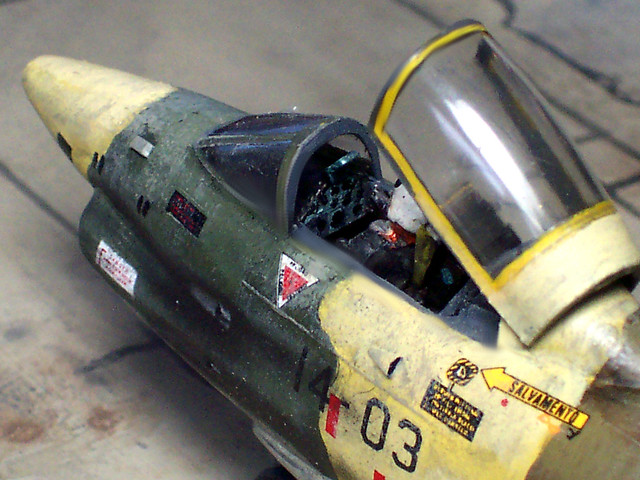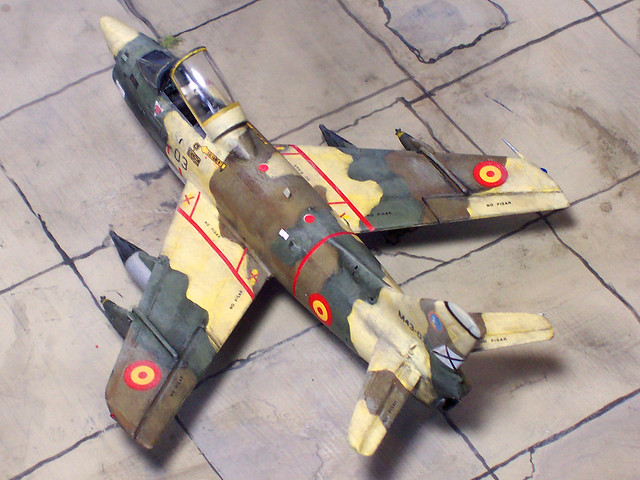...und dies ist Nummer zwei zum "One Week Group Build" auf whatifmodelers.com, hat etwas länger gedauert, alsda größere Eingriffe notwendig wurden: eine fiktionale Gina, und zwar Fiat G.91R/2 '14-03' of Esc. 143, Ala de Caza 14; Spanische Luftwaffe, 1975. Olé!
 Some background:In December 1953, NATO Supreme Command issued specifications for a new light tactical support aircraft. European manufacturers were invited to submit their designs for this requested Light Weight Strike Fighter role. The G.91 was one contender and designed to this specification by the Italian engineer Giuseppe Gabrielli, hence the "G" designation.
Some background:In December 1953, NATO Supreme Command issued specifications for a new light tactical support aircraft. European manufacturers were invited to submit their designs for this requested Light Weight Strike Fighter role. The G.91 was one contender and designed to this specification by the Italian engineer Giuseppe Gabrielli, hence the "G" designation.

 [
[
The competition was intended to produce an aircraft that was light, small, expendable, equipped with basic weapons and avionics and capable of operating with minimal ground support. These specifications were developed for two reasons: the first was the nuclear threat to large air bases, many cheaper aircraft could be better dispersed, and the other was to counter the trend towards larger and more expensive aircraft.
The technical requirements were:
• 1,100 m (3,610 ft) takeoff distance over a 15 m (49 ft) obstacle
• Capability to operate from grass strips and roads
• Maximum speed of Mach 0.95
• Range of 280 km (170 mi) with 10 minutes over the target
• Armoured protection for the pilot and the fuel tanks
• 4 × 12.7 mm (.5 in) or 2 × 20 mm or 30 mm guns
• A maximum of 2,200 kg (4,850 lb) empty weight and 4,700 kg (10,360 lb) max. weight



The challenge of providing an engine that matched the requirements of lightness and power, reliability and ease of maintenance was solved by using the Bristol Siddeley Orpheus turbojet.
Project selections took 18 months to complete and the final selection of the three remaining competing designs was planned for late 1957. In September 1957, at the Centre d'Essais en Vol at Brétigny-sur-Orge, in France, the three rival aircraft types met for evaluation trials. During the trials the Italian aircraft performed impressively and, in January 1958, the Fiat G.91 was officially declared the winner.


Following a meeting of NATO Defence Ministers in April 1958 it was agreed that the G.91 would be the first NATO lightweight strike fighter. A production meeting was planned for May 1958 to discuss the production of the aircraft with financial support from the United States, the Americans would provide some of the finance for the French, German and Italian aircraft and pay for the Turkish aircraft. Other NATO states were supposed to buy the G.91, too., and the defence ministers reached agreement to order 50 aircraft for each country.
Given the large economic and commercial interests at stake, there was a certain amount of controversy surrounding this decision. After the loss of the G.91 prototype, the French government preferred to pursue development of the locally-designed Étendard. The British government similarly ignored the competition to concentrate on Hawker Hunter production for the same role.
The Italian government ordered the G.91 for the Italian Air Force before the results of the competition were known. An initial pre-production batch of machines would later go on to serve for many years with the Italian aerobatic team, the Frecce Tricolori as the G.91 PAN.
The G.91 was also considered by Austria, Norway, Spain, Greece, Switzerland, and even the United States Army, which briefly evaluated the type as a possible Forward Air Control aircraft before relinquishing all fixed-wing aircraft operations to the Air Force.
Spain bought the intended 50 aircraft (42 single seaters called G.91R/2, outfitting two fighter bomber squadrons, plus 8 trainers with tandem seats, comparable with the Italian G.91T/1 trainers), which were produced in Italy from early 1961 onwards and became operational with the Ejército del Aire in late 1962, replacing the F-86 and HA-220 Super Saetas in the ground attack/CAS role.


The G.91R/2 was a hybrid between the simple Italian G.91R/1 and the later, more sophisticated G.91R/4 for Greece and Turkey. It used the R/1's airframe with the modified nose housing three cameras, but already had four underwing hardpoints, structural reinforcements and improved avionics, including a Doppler radar and a revised instrumentation that was also introduced with the Italian R/1A.
The G.91 in Spanish service was already phased out from the mid 70ies onwards and completely retired in 1986, being replaced by F-5 and Mirage F.1.
General characteristics: Crew: 1
Length: 10.3 m (33 ft 9 in)
Wingspan: 8.56 m (28 ft 1 in)
Height: 4.0 m (13 ft 1 in)
Wing area: 16.4 m² (177 ft²)
Empty weight: 3,100 kg (6,830 lb)
Loaded weight: 5,440 kg (11,990 lb)
Max. takeoff weight: 5,500 kg (12,100 lb)
Powerplant: 1× Bristol Siddeley Orpheus 803 turbojet, 22.2 kN (5,000 lbf)
Performance: Maximum speed: 1,075 km/h (580 kn, 668 mph)
Range: 1,150 km (621 nmi, 715 mi)
Service ceiling: 13,100 m (43,000 ft)
Rate of climb: 30 m/s (6,000 ft/min)
Wing loading: 331 kg/m² (67.8 lb/ft²)
Thrust/weight: 0.42
Armament: 4× 12.7 mm (0.50 in) M2 Browning machine guns,
4× under-wing pylon stations holding up to 680 kg/1.500 lb of payload
Ich hatte mit der Spitfire nur drei Tage des GBs "verbraucht", weniger als erwartet, und daher habe ich noch was nachgeschoben... Die Gina ist der antike und sehr einfache Airfix-Bausatz, in diesem Fall sogar eine Japan-Edition:

Dieser wurde dank Spenderteilen des Revell-G.91-Bausatzes ordentlich gepimpt, u.a. mit einem Cockpit, Lufteinlauf, Pylone und Rädern - kann man OOB alles vergessen oder ist erst gar nicht vorhanden! Auch einige Zusatzdetails wie Lufthutzen und Vortex-generatoren am Heck sind ergänzt. Auch die Außenlasten sind komplett neu/aus der Grabbelkiste.
Man muss allerdings zugestehen, dass die Airfix-Gina von der Form
nicht schlecht ist. Aber der Bausatz ist Low-End und über 30 Jahre alt. Dennoch waren überall Spachtelarbeiten vonnöten. Nichts Dramatisches, aber viel - und es lässt sich was draus machen, wer EUR 30,- für den MENG-Bausatz berappt ist m. E. selber Schuld.


Die Idee eines Spaniers kam schlicht aus der Historie, immerhin sollte die G.91 bei allen NATO-Staaten fliegen, aber dazu kam es nicht. Und die spanischen SF-5 mit dem "Minor Asia"-Anstrich haben eine dekorative Vorlage ab, die ich auf die Gina übertragen habe. Bemalt wurde mit Humbrol-Enamels/Pinsel, leicht verwittert/gealtert, die Decals sind allesamt zusammengepuzzelt - der Großteil stammt von einer Heller Mirage IIIE, einiges wurde aber auch improvisiert.

Und das ist dann in fünf Tagen draus geworden - hübsch!





